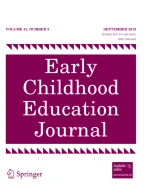Abstract
Mathematics problem solving provides a means for obtaining a view of young children’s understanding of mathematics as they move through the early childhood concept development sequence. Assessment information can be obtained through observations and interviews as children develop problem solutions. Examples of preschool, kindergarten, and primary grade children’s approaches to problem solving are provided in the article. Prekindergarten and kindergarten age children discover problems during play. For example, they figure out how to use informal measurement to use construction materials such as unit blocks and Lego to build a desired building or make a desired object. Moldable materials such as clay and play dough provided shape experiences. The daily sequence of activities builds on their concept of time. Primary grade children solve adult- and child-generated problems. They may use manipulatives and/or drawings to generate problem solutions prior to using symbols and notation. Teacher and/or student devised rubrics can be used to guide evaluation.
Similar content being viewed by others
References
Barlow, A. (2010). Building word problems: What does it take? Teaching Children Mathematics, 17(3), 140–148.
Buschman, L. (2004). Teaching problem solving in mathematics. Teaching Children Mathematics, 10(6), 302–309.
Cathcart, W. G., Pothier, Y., Vance, J., & Bezuk, N. (2006). Learning mathematics in elementary and middle schools (4th ed.). Upper Saddle River, NJ: Pearson, Merrill, Prentice Hall.
Charlesworth, R. (2012). Experiences in math for young children. Belmont, CA: Wadsworth Cengage Learning.
Chenfeld, M. B. (2006). Handcuff me, too! Phi Delta Kappan, 87(10), 745–747.
Diezmann, C. (2008/2009). On-the-spot assessments. Teaching Children Mathematics, 15(5), 290–294.
Donovan, M. S., & Bransford, J. D. (Eds.). (2005). How students learn: History, mathematics and science in the classroom. Washington, DC: National Academies Press.
Ellemor-Collins, D. L., & Wright, R. J. (2008). Assessing student thinking about arithmetic: Videotaped interviews. Teaching Children Mathematics, 15(2), 106–109.
Englard, L. (2010). Raise the bar on problem solving. Teaching Children Mathematics, 17(3), 156–163.
Findell, C. R., Cavanagh, M., Dacey, L., Greenes, C. E., Sheffield, L. J., & Small, M. (2004). Navigating through problem solving and reasoning in grade 1. Reston, VA: National Council of Teachers of Mathematics.
Glanfield, F., Bush, W. S., & Stenmark, J. K. (Eds.). (2003). Mathematics assessment: A practical handbook for grades K-2. Reston, VA: National Council of Teachers of Mathematics.
Golbeck, S. L., & Ginsburg, H.P. (Eds.). (2004). Early Learning in mathematics and science [Special Issue]. Early Childhood Research Quarterly, 19.
Greenes, C. F., Dacey, L., Cavanagh, M., Findell, C. R., Sheffield, L. J., & Small, M. (2003). Navigating through problem solving and reasoning in prekindergarten-kindergarten. Reston, VA: National Council of Teachers of Mathematics.
Heuser, D. (2005). Teaching without telling: Computational fluency and understanding through invention. Teaching Children Mathematics, 11(8), 404–412.
Huinker, D., & Collins, A. M. (Eds.). (2006). Mathematics assessment sampler: Prekindergarten-Grade 2. Reston, VA: National Council of Teachers of Mathematics.
Jacobs, V. R., & Ambrose, R. C. (2008/2009). Making the most of story problems. Teaching Children Mathematics, 15(5), 260–266.
Jacobs, V. R., & Kusiak, J. (2006). Got tools? Exploring children’s use of mathematics tools during problem solving. Teaching Children Mathematics, 12(9), 470–477.
Krechevsky, M. (1998). Project spectrum: Preschool assessment handbook. New York, NY: Teachers College Press.
Leatham, K. R., Lawrence, K., & Mewborn, D. S. (2005). Getting started with open-ended assessment. Teaching Children Mathematics, 11(8), 413–419.
Marshall, J. (2006). Math wars 2: It’s the teaching, stupid!. Phi Delta Kappan, 87(5), 356–363.
Munn, P. (2006). Mathematics in early childhood—the early years curriculum in the UK and children’s numerical development. International Journal of Early Childhood, 38(1), 99–111.
National Council of Teachers of Mathematics. (2000). Principles and standards for school mathematics. Reston, VA: Author. www.nctm.org.
National Council of Teachers of Mathematics. (2009). Alternate forms of assessment. www.nctm.org.
Outhred, L., & Sardelich, S. (2005). “A problem is something you don’t want to have”: Problem solving by kindergartners. Teaching Children Mathematics, 12(3), 146–155.
Seo, K. (2003). What children’s play tells us about teaching mathematics. Young Children, 58(1), 28–33.
Shaw, J., Chambless, M., Chessin, D., Price, V., & Beardain, G. (1997). Cooperative problem solving: using k-w-d-l as an organizational technique. Teaching Children Mathematics, 3(9), 482–486.
Silver, E. A., & Cai, J. (2005). Assessing children’s mathematical problem posing. Teaching Children Mathematics, 12(3), 129–135.
Skinner, P. (1990). What’s your problem? Posing and solving mathematical problems, k-2. Portsmouth, NH: Heinemann.
Small, M., Sheffield, L. J., Cavanagh, M., Dacey, L., Findell, C. R., & Greenes, C. E. (2004). Navigating through problem solving and reasoning in grade 2. Reston, VA: National Council of Teachers of Mathematics.
Smith, N., Lambdin, D., Lindquist, M., & Reyes, R. (2004). Teaching elementary mathematics: A resource for field experience (2nd ed.). Hoboken, NJ: Wiley.
Snow, C. E., & Van Hemel, S. B. (Eds.). (2008). Early childhood assessment: Why, what and how. Washington, DC: The National Academies Press.
Starkey, P., Klein, A., & Wakely, A. (2004). Enhancing young children’s mathematical knowledge through a pre-kindergarten mathematics intervention. Early Childhood Research Quarterly, 19, 99–120.
Stenmark, J. (Ed.). (1991). Mathematics assessment: Myths, models, good questions, and practical suggestions. Reston, VA: National Council of Teachers of Mathematics.
Stipek, D. (2006). Accountability comes to preschool: Can we make it work for young children? Phi Delta Kappan, 87(10), 740–744, 747.
Van De Walle, J. (2007). Elementary and middle school mathematics: teaching developmentally (6th ed.). New York: Pearson, Allyn & Bacon.
Wells, P. J., & Coffey, D. C. (2005). Are they wrong? Or did they just answer a different question? Teaching Children Mathematics, 12(4), 202–207.
Young-Loveridge, J. M. (2004). Effects on early numeracy of a program using number books and games. Early Childhood Research Quarterly, 19, 82–98.
Author information
Authors and Affiliations
Corresponding author
Rights and permissions
About this article
Cite this article
Charlesworth, R., Leali, S.A. Using Problem Solving to Assess Young Children’s Mathematics Knowledge. Early Childhood Educ J 39, 373–382 (2012). https://doi.org/10.1007/s10643-011-0480-y
Published:
Issue Date:
DOI: https://doi.org/10.1007/s10643-011-0480-y
